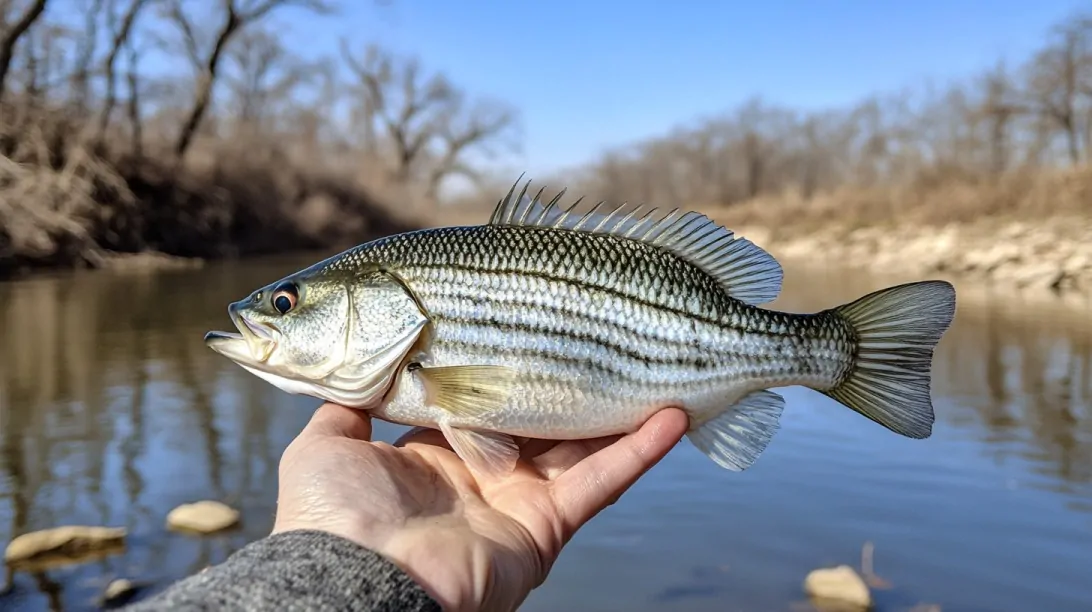Primary Spawn: April-May (peak: late April to mid-May) when water temperatures reach 58-68°F; optimal spawning occurs at 60-64°F; triggered by combination of water temperature and increasing day length; typically 2-3 weeks after ice-out or when spring warming begins
Spawning Habitat: Shallow gravel bars, rocky areas, and creek mouths with current in 3-10 feet of water; strong preference for areas with moderate current providing oxygen and preventing silt accumulation on eggs; tributary streams and creek mouths primary spawning locations; riprap areas, dam spillways, and wind-swept gravel points also used; prefer hard bottom (gravel, rubble, coarse sand) free of silt and vegetation
Reproductive Behavior: Pre-spawn Migration (March-April): As water temperatures reach 50-55°F, white bass begin migrating from deep winter holding areas toward spawning grounds; fish stage in deeper water (15-25 feet) near spawning areas feeding heavily on baitfish; concentration of fish in staging areas creates excellent pre-spawn fishing; schools become increasingly dense as spawn approaches
Spawning Run: When water reaches 58-60°F, massive schools move into shallow spawning areas; fish concentrate in creek mouths, current areas, and gravel bars; spawning activity can involve hundreds or thousands of fish; peak activity occurs during dawn and dusk but continues throughout day during peak spawn
Spawning Act: Highly social spawning—no nest building or pair bonding; large groups congregate over suitable substrate; females surrounded by multiple males (typically 3-8 males per female); spawning occurs near surface with visible splashing and rolling; female broadcasts 250,000-900,000 non-adhesive eggs over gravel while surrounded by males releasing milt; eggs are semi-buoyant and settle into gravel crevices; spawning act lasts 5-10 seconds per episode; females may spawn multiple times over 2-3 day period; males remain in spawning areas longer than females, participating with multiple females
No Parental Care: After spawning, adults immediately abandon eggs; no nest guarding or fry protection; eggs susceptible to predation from other fish, crayfish, and aquatic insects; high reproductive output compensates for lack of parental care
Post-Spawn Behavior: After spawning, adults remain in shallow areas feeding heavily for 1-2 weeks recovering energy; gradually move back to main lake following baitfish schools; excellent post-spawn fishing as fish are aggressive and accessible; fish disperse throughout system over several weeks; resume normal roaming patterns following shad schools
Egg and Fry Development: Eggs hatch in 2-3 days at optimal temperatures (60-65°F); newly hatched larvae are approximately 3-4mm long; larvae drift with current initially, feeding on yolk sac; become free-swimming after 5-7 days; young white bass school immediately—instinct present from birth; feed on zooplankton initially; at 1-2 inches begin feeding on aquatic insects and tiny fish; at 2-3 inches transition to fish diet; rapid growth first year; young-of-year form large schools in shallow protected areas; high mortality rate first year (90%+) from predation; males reach sexual maturity at 2-3 years (8-10 inches); females mature at 3-4 years (10-12 inches)
Multiple Spawning: White bass may spawn 2-3 times in a single season if conditions remain favorable; later spawns less intense than initial spawn; extended spawning period (4-6 weeks total) increases recruitment success

